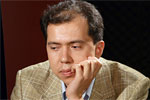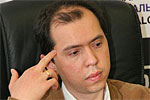What exactly is the problem of draws in chess?
Two recent proposals (by GM
Rustam Kasimdzhanov and GM
Sergei Shipov) have led to considerable discussion about draws in chess. As
my own contribution to the debate, I thought it might be helpful to provide
some objective numbers. I don't think I have ever written an analysis specifically
aimed at draws; it is time to remedy this!
Before anything else, there are two very important things you should know about
draws.
-
The smaller the rating gap between two players, the more likely it is that
they will draw.
-
The stronger the two players are, the more likely it is that they will
draw.
These two points are easily illustrated with a couple of simple graphs, based
on all available FIDE-rated games over the past ten years:

In the above graph, you can see that evenly-matched players will draw about
40% of the time, but this drops down steadily, reaching 20% when the rating
difference is 250 Elo points and eventually getting very close to zero when
the rating difference is 700-800 Elo points. Of course, this doesn't mean that
world championship events should typically see about 40% draws; remember that
this graph includes results from players of all strengths, even down near the
bottom of the rating pool. We have to also consider the second important point,
which has an even bigger impact on draw rates:

Here we see that at the lowest levels, draws happen less than 25% of the time,
increasing up to 40% frequency as you pass the 2500-level. The strongest players
have draws in almost 60% of their games - note that this is a combined figure,
from their games against other elite players as well as against other players.
Taking these two points together, we see that the place we might even expect
a draw rate above 60% is precisely the area under the heaviest public scrutiny:
namely, the games between evenly-matched, elite players. And indeed, across
all the games from the past ten years played between players rated 2700+, we
have seen 65% draws.
You might wonder, is the problem getting worse? That of course is a vital question;
if the situation is already getting better, we probably don't need radical change. It
would be interesting to see what has happened over time, with regard to draw
rates. And we are specifically interested in looking at the most elite level.
However, this brings up an interesting problem: how do we search for the most
elite games? We can't just use FIDE rating, because of the huge impact of rating
inflation over the years. Although currently there are about 600 games played
each year between players both rated 2700+, the first recorded instance of such
a game was in 1980 (two games played between Anatoly Karpov and Mikhail Tal). Then
from 1981 through 1990 there were 154 games played between players both rated
2700+, but they were all Karpov-Kasparov games! And if we tried to lower our
standards and search on games played between 2600+ or 2500+ players, we would
get skewed data from recent years because they would include so many players
who currently are not even in the top 100.
In fact, I feel that the best way to look for "elite games" is to
use players' ranks on the rating list, rather than their absolute FIDE ratings. From
inspecting each FIDE rating list through history, we can identify who was in
the top 10, the top 20, the top 100, etc., and confine our analysis to only
games played among such players. This takes us back to about 1975, but we can
go much further back in time through the use of my historical Chessmetrics ratings. In
fact we can go all the way back to 1900:

This graph looks only at games played each year between players rated in the
top ten. The individual X's show the draw rate in each year, whereas the solid
black line is more useful and indicates the overall trend line. You only see
the X's for years having a certain minimum number of elite games. We can see
that from 1900 through 1925, the draw rate among elite players was about 40%
to 50%, then from 1925 through 1960, the draw rate gradually increased from
50% to 60%, and then it stayed fairly constant at 60% for many years, until
the mid-1980's, which saw a big drop almost to 50%. And for the past two decades
the draw rate at the top has been slowly creeping up, to the point where it
is now at historically high levels again, just about 70%.
To keep you interested, let's pause for a quick trivia question. Without looking
back at the graph, try to answer this question: Over the past 60 years, which
single year saw the lowest draw percentage in the games among top-ten players? Okay…
now look up at the graph. Where is the lowest X between 1950 and 2011? At 1971,
the year of Bobby Fischer's three candidates' matches. So despite the attempt
to describe overall trends, you can still see the impact of one unusual player
on these numbers.
Because we are only talking about the top ten, these figures can indeed be
significantly impacted by one or two players in the top ten who happen to be
unusually conservative (or aggressive). Therefore, while this graph is interesting,
it is perhaps better, if we want to get a sense of what was happening in "elite
chess", to look at draw rates among players in the top 100, rather than
just the top ten. This shows us basically the same trends, but it is less susceptible
to the effects of individual players, unless they are very influential! Of course,
it doesn't really make sense to talk about a "top 100" when your rating
list itself is not even 100 players long, so that is why this graph only starts
at 1925 (the Chessmetrics rating lists prior to 1925 are not long enough):

And finally, if you are wondering about master-level chess in general, and
not just the top 100, we could look across time and draw this same graph for
just the games played among players within a certain distance from the top ten. That
manages to sidestep the inflation problem rather neatly, and incorporates a
much larger pool of players so that we have more information for the graph. For
instance, if we look only at games played among players rated within 400 points
of the top ten, that currently gives us 40,000 games per year to consider, and
has been more than 1,200 games in each year since 1949. Looking at this next
graph, we see that for chess in general, the draw rate is holding pretty steady
around 50%, and is only increasing at a very slow rate:

I feel that people are perhaps too critical of the draw. It is a vital part
of the rating system, allowing a reasonable way for weaker players to reach
some level of success in a game against a stronger opponent. The rating system,
the Swiss pairing system, the performance rating calculation… all of these things
are much more elegant and precise than they would be if we didn't have draws. And
in many cases, a drawn result is the perfect and logical outcome of a well-matched
struggle.
Do we actually feel bad, ashamed on behalf of chess, when someone salvages
a perpetual check or constructs a brilliant fortress? I don't feel defensive
when that happens; I think it's exciting. What could be a more perfect result
than players inexorably being forced into repetition because for either player
to deviate would mean defeat? That is part of chess, and we should embrace that
kind of drawn result rather than criticizing it. On the other hand, I do feel
embarrassed when two players agree to a draw from a position that is still very
much unresolved. There is nothing wrong with playing conservatively, maintaining
the margin of a draw through to the end when it is clear that neither side can
force victory. That is also a vital part of chess and tournament strategy. But
agreeing to a draw on move 13, when there is no possible way to force a draw
even with very conservative play... to me that is an embarrassment and has the
flavor of collusion to an outside observer. So I feel the problem is not "too
many draws", but rather is "too many abrupt ends to unresolved positions".
However, it is difficult for me to measure or graph whether a draw happened
in an "unresolved position", so instead I decided to look, not just
at the percentage of draws, but (rather) the percentage of "short draws".
And here we see that the news is not all bad! It appears that the short draw
is rapidly disappearing from elite games.

Several of the previous graphs had shown a significant decline in drawn games
from the early 1980's until the early 1990's, and then draw rates gradually
rising to historic levels by 2011. However, we don't quite see this same trend
for short draws. Yes, they peaked in the early 1980's, and yes, they dropped
gradually to a historic low in the early 1990's. But after the rate of short
draws gradually climbed during the 1990's and early years of this century, they
took a steep dive starting in 2006, and the rate of short draws is now at an
all-time low! For instance, in 2010, less than 5% of all games played among
top-ten players resulted in short draws! You can see from the above graph that
this had never happened in the previous 35 years of elite chess. I think that
is something for us to be proud of, not something we should seek to change.
Perhaps the existing measures to discourage draws among top players are working
well enough. And perhaps it would be more appropriate to focus our attention
on how to discourage the premature draw offer, rather than working to discourage
the draw itself.
During the course of this analysis, I also looked at individual players and
individual openings. I wondered, for instance, whether the "notorious"
openings such as Petroff's Defense do indeed yield the highest draw rates at
the elite level, and whether the unusual draw rates for some of the biggest
names can be attributed to the openings they choose, or rather to how they impose
their style of play on any opening. I found some interesting things, which
I will be describing soon in a follow-up article…
Previous related articles
 |
Kasimdzhanov: Open letter to FIDE – with a proposal
21.07.2011 – Uzbek-born grandmaster and former
FIDE knockout world champion Rustam Kasimdzhanov, now a permanent second
of World Champion Vishy Anand, is a profound thinker, and not just in
chess openings. He has now written an open letter to FIDE, describing
the current unsatisfactory situation in top professional chess and proposing
a
startling solution. |
 |
Kasimdzhanov's proposal – our readers react
03.08.2011 – Two weeks ago former FIDE world
champion Rustam Kasimdzhanov made a startling proposal, designed to lift
chess out of what he perceives to be a crisis: eliminate draws by playing
rapid and then blitz games if there is no decisive result. Naturally our
readers commented on this idea with vigor – and many with interesting
counter-proposals. Here is a (very large) selection
of letters. |
 |
Shipov: Chess as a sport and the three-point system
07.08.2011 – Sergei Shipov is a Russian grandmaster
(peak Elo 2662), trainer of many top players and talented juniors, journalist
and author. His web site Crestbook is well appreciated by Russian fans,
as is his live commentary in top events. Sergei sent us the following
article, in which he weighs in on our recent debate, initiated by GM Rustam
Kasimdzhanov, on draws
in chess. |
 |
The Kasimdzhanov/Shipov draw proposals – readers' feedback
19.08.2011 – Former FIDE World Champion Rustam
Kasimdzhanov recently proposed that there were too many draws in chess,
and that eliminating them from top-level chess would greatly enhance the
popularity of the game. After him GM Sergei Shipov made a similar proposal,
involving tie-break rapid or blitz games to be played immediately after
draws. Here a selection of reactions
from our readers.
|
Copyright
Sonas/ChessBase

































